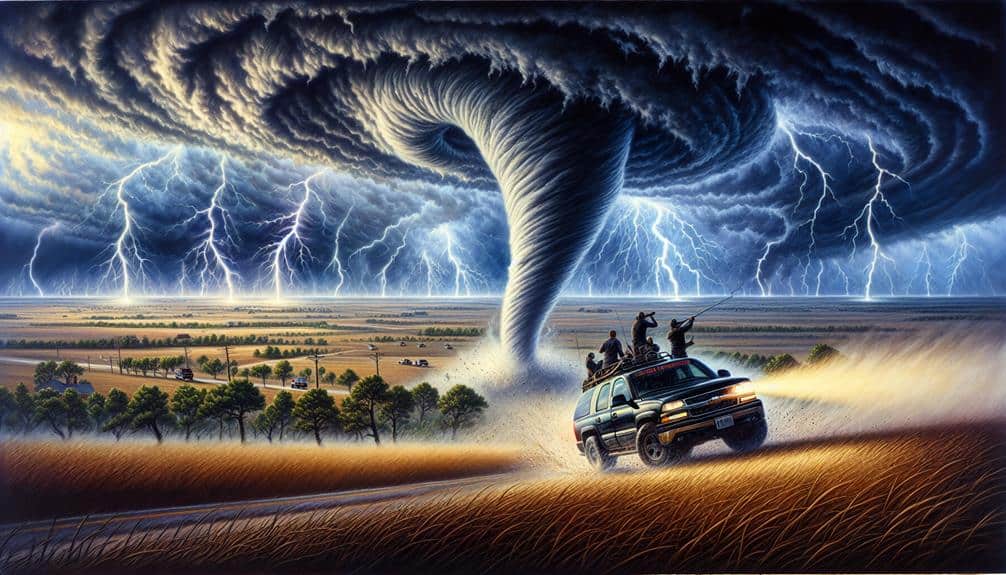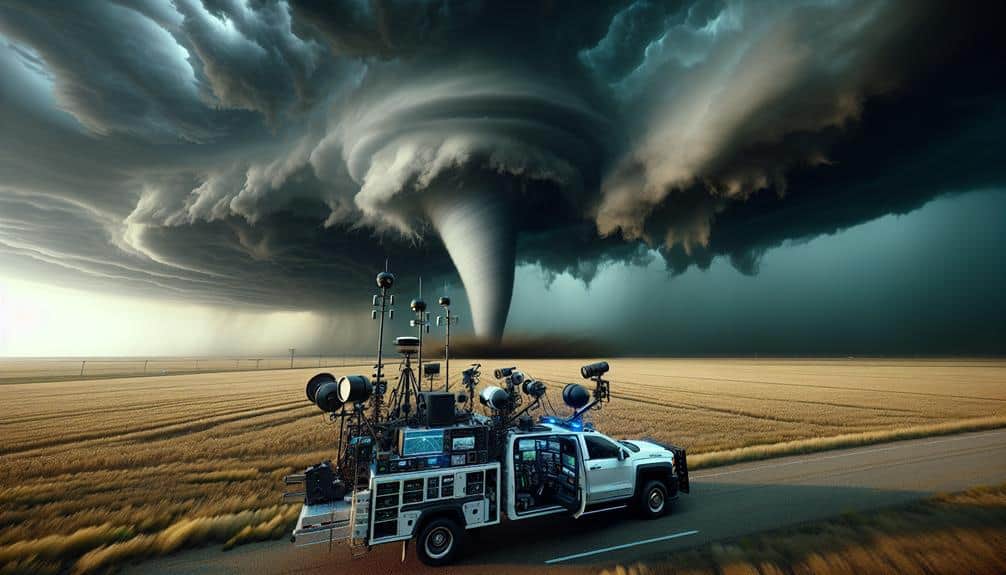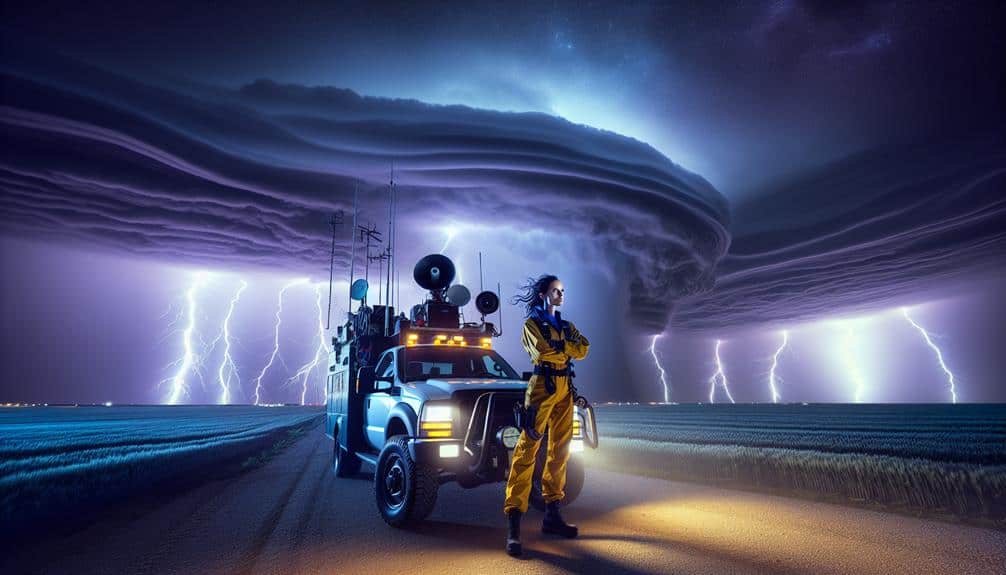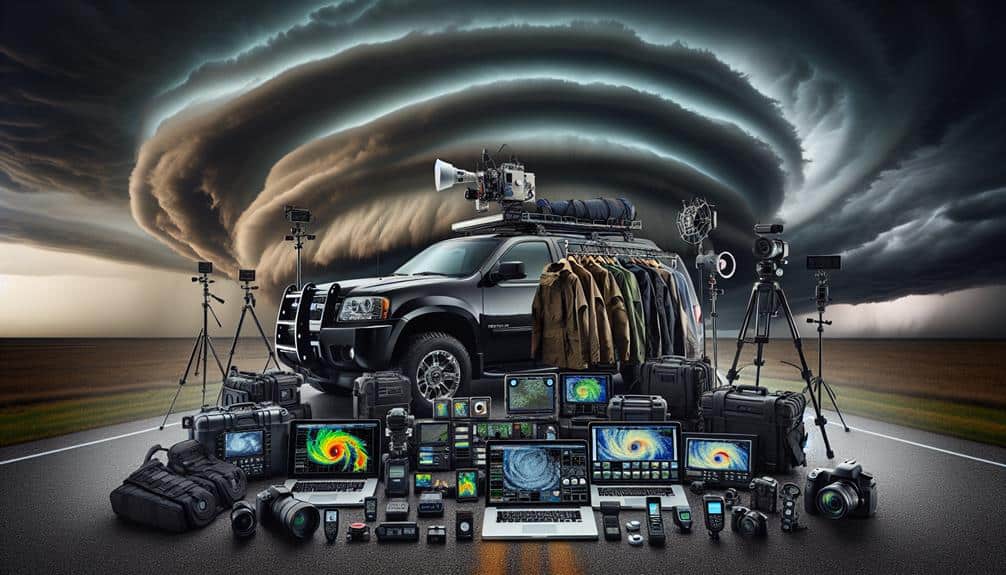Let's delve into the top ten tornado chasing adventures in Tornado Alley. In Kansas, we'll utilize Doppler radar to track twisters, while Oklahoma's supercell safari lets us analyze atmospheric data in real-time. Texas offers a tornado expedition where we meticulously document storm structures. In Nebraska, we hunt funnels, while South Dakota provides thrilling storm hunts. Missouri's twister trek and Iowa's tracking tours focus on mesocyclone observations. Arkansas and Illinois round out the list with advanced meteorological equipment for precision chasing. For data-driven thrill-seekers wanting scientific exploration, these adventures promise invaluable insights and the raw power of tornadoes. Discover the full details.
Key Points
- Experience tornado tracking with Doppler radar and satellite imagery for precise storm monitoring.
- Safeguard your adventure with fortified vehicles and emergency plans tailored for extreme weather conditions.
- Gain insights from local expert guides familiar with Tornado Alley's weather patterns and optimal viewing spots.
- Utilize high-resolution cameras and portable Doppler radar to document supercell formations and tornado behavior.
Kansas Twister Pursuit
In our Kansas Twister Pursuit, we utilized Doppler radar and satellite imagery to track the formation and trajectory of tornadoes with high accuracy. By analyzing atmospheric data, we identified key indicators such as wind shear, humidity, and temperature gradients that signaled potential tornado genesis. This data-driven approach facilitated precise positioning to capture storm photography, providing both a scientific research edge and an extreme weather thrill.
Our methodology included real-time data analysis while in the field. The Doppler radar allowed us to monitor storm cell rotation, giving us the ability to predict tornado formation with a lead time of several minutes. Satellite imagery complemented this by offering a broader view of storm systems, enabling us to anticipate shifts in storm trajectories. This combination fueled our adrenaline rush, knowing we were at the forefront of extreme weather phenomena.
Through our Kansas Twister Pursuit, we contributed valuable data to meteorological studies while embracing the freedom that comes with chasing nature's most powerful forces. Our storm photography not only documented these awe-inspiring events but also provided visual evidence to support our scientific findings. Each successful chase reinforced our commitment to advancing tornado research and satisfying our quest for adventure.
Oklahoma Supercell Safari
Our Oklahoma Supercell Safari employed advanced meteorological tools to meticulously track and analyze supercell structures, enhancing our understanding of tornado formation dynamics. Utilizing Doppler radar and satellite imagery, we monitored storm cells in real-time, allowing us to predict potential tornado genesis with remarkable accuracy. This approach not only maximized our safety but also provided invaluable data for future storm chasing endeavors.
Storm chasing in Oklahoma delivers an unparalleled adrenaline rush. The raw power of extreme weather demands respect and careful planning. Here are some key aspects that made our safari exceptional:
- Real-time data analysis: Leveraging cutting-edge technology to stay ahead of developing storms.
- Safety protocols: Implementing rigorous safety measures to protect our team.
- Photography tips: Capturing high-resolution images of supercell structures requires understanding light conditions and camera settings.
Being amidst these powerful supercells, we felt a profound sense of freedom. The vast Oklahoma plains provided an unobstructed view, perfect for observing the intricate dance of nature's fury. The experience was both humbling and exhilarating, blending scientific inquiry with the sheer thrill of storm chasing.
Texas Tornado Expedition
In our Texas Tornado Expedition, we've identified prime viewing spots based on historical tornado frequency data and meteorological patterns.
We must implement rigorous safety precautions, including real-time weather monitoring and emergency protocols.
These measures are essential to minimize risks while maximizing observational accuracy.
Prime Viewing Spots
Texas' extensive plains and variable weather patterns provide some of the most ideal conditions for tornado observation and research. As we travel through Tornado Alley, our data-driven approach allows us to pinpoint prime viewing spots that maximize storm photography opportunities and enhance our comprehension of severe weather phenomena.
When selecting these locations, we consider several crucial factors:
- Topography: The flat terrain of Texas' plains offers unobstructed views, essential for capturing high-quality storm photography with the best equipment.
- Historical Tornado Data: We analyze past weather patterns to identify regions with a high frequency of tornado activity.
- Accessibility: Proximity to major roads ensures we can navigate quickly and adjust our position as storms develop.
Our expeditions often focus on regions such as the Panhandle, where the convergence of dryline and moist air masses creates optimal conditions for tornado formation. By leveraging advanced meteorological tools and historical data, we not only capture the raw power of these storms but also contribute to broader scientific understanding.
This approach underscores our commitment to both exploration and safety, ensuring we can chase the next storm with confidence and precision.
Safety Precautions Required
How do we safeguard the highest level of safety while pursuing tornadoes in the unpredictable terrains of Texas?
First, rigorous risk assessment is crucial. We analyze historical tornado data to identify patterns and potential hotspots. Utilizing advanced weather monitoring tools, we track storm development in real-time, ensuring we're always informed of the latest conditions.
Safety gear is non-negotiable. We equip ourselves with helmets, protective suits, and sturdy footwear to shield against debris. Additionally, we carry emergency plans, including first aid kits, communication devices, and detailed evacuation routes. These plans are continually updated based on the latest meteorological data.
Our vehicles are fortified for extreme weather. Reinforced frames and shatterproof windows help us withstand high winds and flying debris. We also verify that our vehicles are stocked with essential supplies like water, food, and fuel for extended stays.
Our team adheres strictly to predefined safety protocols. We maintain constant contact with local authorities and weather services, allowing us to adapt our plans swiftly. Freedom drives our adventures, but we never compromise on safety.
Nebraska Funnel Frenzy
The Nebraska Funnel Frenzy provided a unique opportunity to analyze the formation and behavior of multiple tornadoes within a concentrated area, yielding valuable data on their rapid development and path trajectories. We observed an array of extreme weather phenomena, capturing stunning storm photography that highlighted the dramatic interplay of light and storm dynamics. Our adrenaline rush was palpable as we tracked these powerful tornadoes, immersing ourselves in the intricate dance of shifting weather patterns.
Our data collection focused on several key aspects:
- Tornado Genesis: Documenting the precise conditions that triggered tornado formation.
- Path Trajectories: Mapping the movement and speed of tornadoes to understand their unpredictable paths.
- Intensity Metrics: Measuring wind speeds and pressure drops to quantify tornado strength.
South Dakota Storm Hunt
Our South Dakota Storm Hunt enabled us to meticulously document several supercell formations, providing vital insights into their lifecycle and potential for tornadogenesis. We observed a fascinating array of weather patterns, including the mesocyclone structure and associated inflow notches, which are essential indicators of storm rotation and the likelihood of tornado development.
Through storm photography, we captured high-resolution images of wall clouds and anvil clouds, allowing us to analyze the visual markers that precede tornadogenesis. These images, coupled with Doppler radar data, helped us correlate visual phenomena with radar signatures, enhancing our predictive capabilities.
Data collected from our mobile weather stations revealed significant variances in temperature, humidity, and wind shear across different supercell formations. These measurements are pivotal for understanding the environmental conditions that foster severe weather events. We recorded wind speeds exceeding 60 mph and noted the rapid drop in barometric pressure characteristic of tornadic activity.
Colorado Cyclone Chase
Shifting our focus to the Colorado Cyclone Chase, we meticulously tracked a sequence of intense supercells, documenting their formation, evolution, and the environmental parameters contributing to their development. Our objective was clear: capture the raw power of extreme weather through precise storm photography and thorough data collection.
Analyzing the atmospheric conditions, we observed several critical factors that influenced the supercells' behavior:
- Dew point gradients: High moisture content, combined with steep lapse rates, provided the necessary instability.
- Wind shear: Directional and speed shear in the lower troposphere facilitated the rotation within the storm.
- Mesoscale boundaries: Interactions with frontal boundaries and outflow boundaries played a pivotal role in storm initiation.
Our equipment, including portable Doppler radar and high-resolution cameras, enabled us to document these supercells with scientific precision. We captured high-definition images and video, highlighting the structural nuances of the rotating updrafts, wall clouds, and, occasionally, the formation of tornadoes.
This adventure underscored the importance of understanding environmental dynamics in storm development. By combining data-driven analysis with storm photography, we not only documented but also deepened our understanding of these formidable natural phenomena, all while embracing the freedom of the open plains.
Missouri Twister Trek

Starting the Missouri Twister Trek, we carefully analyzed meteorological data to pinpoint regions with ideal conditions for tornado formation. Using Doppler radar, satellite imagery, and surface observations, we identified significant wind shear, moisture convergence, and instability over central Missouri. These parameters suggested a high probability of extreme weather, specifically supercell thunderstorms capable of producing tornadoes.
Our storm chasing tours began with a strategic briefing on safety protocols and best tornado photography techniques. Equipped with high-resolution cameras and GPS devices, we set off on our adrenaline rush-filled journey, focusing on areas with heightened convective potential. As we tracked the developing supercells, we observed classic hook echoes on radar, indicative of potential tornado genesis.
Upon reaching our designated observation points, we noticed the rapid development of wall clouds and rotating updrafts, confirming the presence of mesocyclones. These features are crucial for tornado formation, and our team maintained a safe distance while capturing stunning images of the evolving storm structure. The interplay of light and shadow during these moments provided exceptional opportunities for capturing the raw power of nature.
Throughout the Missouri Twister Trek, the combination of scientific analysis and real-time observation highlighted the unpredictable beauty and danger inherent in extreme weather phenomena.
Iowa Tornado Tracking
After successfully documenting Missouri's turbulent tornadoes, we turned our focus to Iowa, where meteorological data indicated a significant likelihood of tornadic activity. Utilizing advanced storm prediction models, we identified several key factors contributing to tornado formation in this region. These included atmospheric instability, wind shear, and moisture convergence. Our goal was to capture real-time data and assess severe weather patterns to enhance emergency preparedness strategies.
In Iowa, we meticulously tracked storm cells and noted the following:
- Tornado Formation: By monitoring supercell thunderstorms, we observed the critical stages of tornado genesis.
- Storm Prediction: Using Doppler radar, we could predict storm paths with impressive accuracy, enabling timely alerts.
- Severe Weather: We documented various severe weather phenomena, from hail to strong winds, providing a thorough understanding.
Through scientific rigor and objective analysis, we aimed to empower individuals with the freedom to stay informed and take necessary precautions.
Iowa's unique meteorological conditions offered a prime opportunity to deepen our understanding of tornado dynamics and contribute valuable insights to the field of severe weather research.
Arkansas Storm Adventure

In Arkansas, we leveraged our expertise in meteorological analysis to investigate the region's severe storm patterns and potential tornado formation. By analyzing Doppler radar data, atmospheric pressure readings, and wind shear metrics, we pinpointed the most likely zones for tornado genesis. Our real-time data integration ensured we were always in the best position to document nature's power.
Engaging in storm photography during these chases allowed us to capture both the beauty and ferocity of extreme weather events. High-resolution cameras and specialized equipment provided invaluable visual data, contributing to our understanding of storm structure and behavior. Each click of the shutter fueled our adrenaline rush, propelling us further into the heart of the storm.
We utilized mobile weather stations to measure temperature gradients and humidity levels, important in predicting tornado formation. This scientific approach wasn't just thrilling but also instrumental in advancing our knowledge of severe weather phenomena. Our findings weren't only academically significant but also provided a sense of freedom, as we embraced the unpredictability of nature's power.
In essence, our Arkansas Storm Adventure underscored the significance of meticulous preparation and precise execution in the pursuit of understanding and experiencing extreme weather.
Illinois Vortex Voyage
In Illinois, we focus on the prime tornado season from April to June, aligning with peak atmospheric instability and wind shear data.
Our essential chase gear includes Doppler radar systems, anemometers, and high-resolution cameras to capture precise meteorological data.
Partnering with local expert guides enhances our situational awareness and guarantees we navigate safely through high-risk zones.
Prime Tornado Season
Illinois' main tornado season typically spans from late April to early June, with peak activity observed in May when atmospheric conditions are most favorable for vortex formation. During this period, we focus on detailed tornado season preparations and storm watching tips to guarantee safety and successful observations. Understanding weather forecasting techniques and participating in emergency response training are essential for staying ahead of rapidly developing storms.
Key factors contributing to tornado genesis in Illinois include:
- Temperature Contrasts: Sharp differences between warm, moist air from the Gulf of Mexico and cooler, dry air from Canada.
- Wind Shear: Changes in wind speed and direction with altitude that promote rotation.
- Atmospheric Instability: Rising warm air that cools and condenses, forming thunderstorms.
Essential Chase Gear
Equipped with the right gear, we enhance our chances of both witnessing tornadoes and ensuring our safety during the Illinois Vortex Voyage. Our chase vehicle is our mobile command center, fortified with Doppler radar systems, GPS units, and anemometers for real-time data collection. These instruments provide precise metrics on wind speed, direction, and atmospheric pressure, enabling us to make informed decisions rapidly.
Inside our chase vehicle, we prioritize safety with reinforced windows and chassis to withstand debris impact. Our communication system includes multi-band radios and satellite phones, ensuring connectivity even in remote areas. Cameras with high-resolution capabilities and wide-angle lenses allow us to document tornadoes from a safe distance.
In case of imminent danger, we've a storm shelter strategy ready. Portable storm shelters, tested to withstand EF5 tornado conditions, are essential in our gear. These shelters are lightweight yet robust, providing protection when evacuation isn't an option.
Our chase gear isn't just about observing storms; it's about maximizing our freedom to explore while minimizing risks. By leveraging technological advancements and rigorous planning, we can experience the raw power of tornadoes safely and scientifically.
Local Expert Guides
Our local expert guides bring valuable knowledge and experience, offering precise insights into the unique weather patterns of Tornado Alley. Their expertise allows us to navigate the complexities of tornado formation with a level of accuracy that only local knowledge can provide. For our Illinois Vortex Voyage, we rely on their expert advice to identify best chase zones, increasing our chances of witnessing these awe-inspiring natural phenomena.
Local guides utilize advanced meteorological tools and up-to-date atmospheric data to track storm cells. Their familiarity with regional topography optimizes our routes, guaranteeing safety and efficiency. The combination of advanced technology and years of hands-on experience provides a thorough understanding of tornado behavior, essential for a successful chase.
- Meteorological Tools: High-resolution Doppler radar and satellite imagery for real-time storm tracking.
- Atmospheric Data: Analysis of temperature, humidity, and wind patterns to predict tornado formation.
- Route Optimization: Knowledge of local roads and terrain to navigate safely and swiftly.
Our pursuit of freedom and adventure is guided by these experts, whose local knowledge and scientific expertise ensure not only an exciting experience but also our utmost safety.
Frequently Asked Questions
What Should I Pack for a Tornado Chasing Adventure?
For a tornado chasing adventure, we should pack essential gear like weather radios, GPS devices, and first aid kits. Packing tips include bringing durable clothing and waterproof gear. This guarantees safety and maximizes our data collection efficiency.
Are There Age or Health Restrictions for Participants?
We must consider age requirements and health limitations. Participant qualifications include meeting physical restrictions to guarantee safety. While specific data varies, generally, participants should be over 18 and in good physical health. Safety is our priority.
How Safe Are These Tornado Chasing Tours?
We prioritize safety precautions and employ advanced equipment to monitor storm patterns. Our rigorous risk assessment and emergency procedures guarantee participant safety while preserving the thrill of adventure. It's a balanced approach to experiencing nature's power responsibly.
What Time of Year Is Best for Tornado Chasing?
We find that late spring, particularly May to early June, offers the best locations for tornado chasing due to ideal weather conditions. Data shows peak tornado activity, maximizing our chances for successful observations.
Do I Need Any Special Insurance for These Trips?
Given the tornado chasing risks, insurance coverage is essential. Many tornado tours recommend additional insurance to cover potential damages or injuries. It's important we evaluate our current policies to make sure we're properly protected on these adventures.


